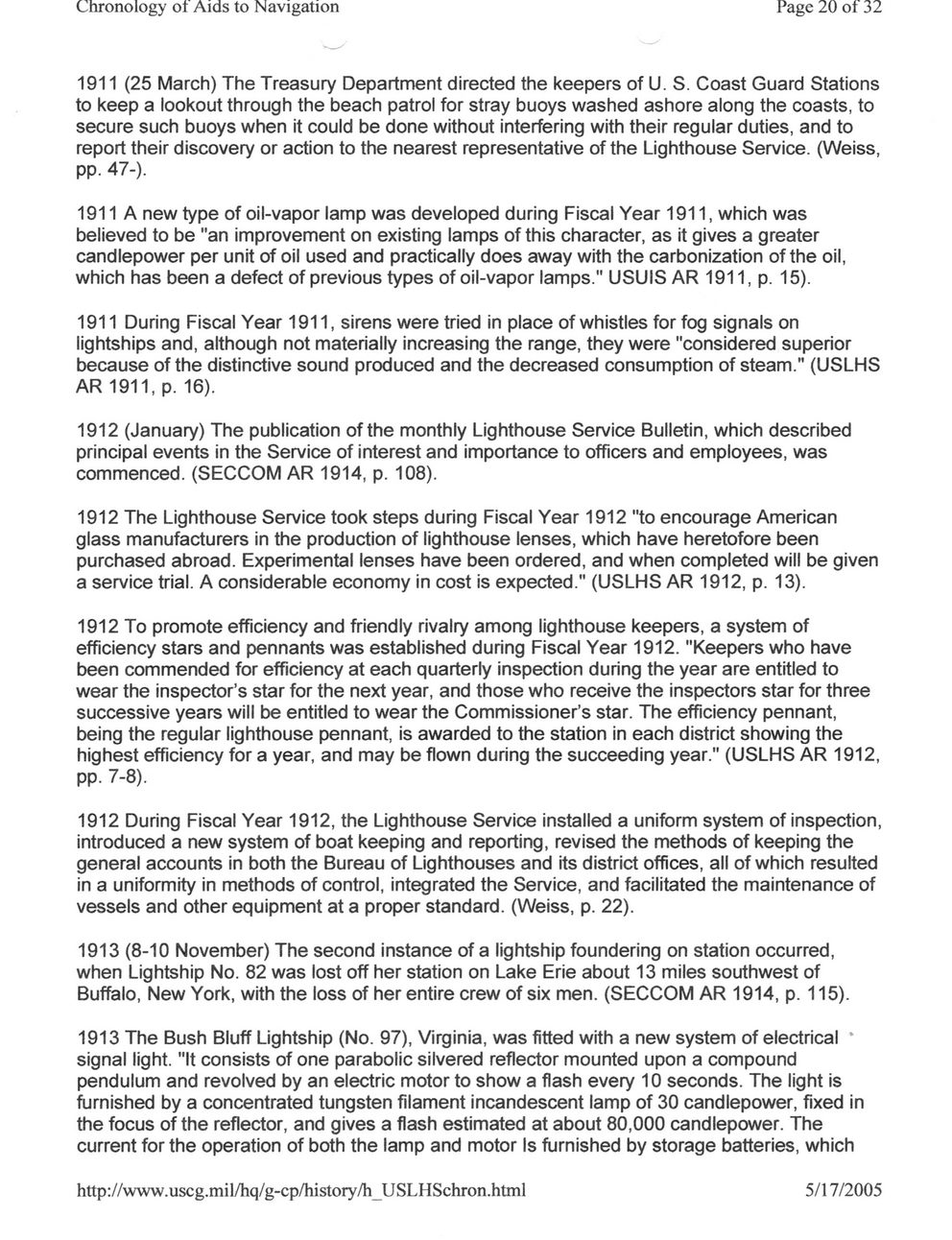This text was obtained via automated optical character recognition.
It has not been edited and may therefore contain several errors.
Chronology 01 Aids to Navigation Page 20 of 32 1911 (25 March) The Treasury Department directed the keepers of U. S. Coast Guard Stations to keep a lookout through the beach patrol for stray buoys washed ashore along the coasts, to secure such buoys when it could be done without interfering with their regular duties, and to report their discovery or action to the nearest representative of the Lighthouse Service. (Weiss, pp. 47-). 1911 A new type of oil-vapor lamp was developed during Fiscal Year 1911, which was believed to be "an improvement on existing lamps of this character, as it gives a greater candlepower per unit of oil used and practically does away with the carbonization of the oil, which has been a defect of previous types of oil-vapor lamps." USUIS AR 1911, p. 15). 1911 During Fiscal Year 1911, sirens were tried in place of whistles for fog signals on lightships and, although not materially increasing the range, they were "considered superior because of the distinctive sound produced and the decreased consumption of steam." (USLHS AR 1911, p. 16). 1912 (January) The publication of the monthly Lighthouse Service Bulletin, which described principal events in the Service of interest and importance to officers and employees, was commenced. (SECCOM AR 1914, p. 108). 1912 The Lighthouse Service took steps during Fiscal Year 1912 "to encourage American glass manufacturers in the production of lighthouse lenses, which have heretofore been purchased abroad. Experimental lenses have been ordered, and when completed will be given a service trial. A considerable economy in cost is expected." (USLHS AR 1912, p. 13). 1912 To promote efficiency and friendly rivalry among lighthouse keepers, a system of efficiency stars and pennants was established during Fiscal Year 1912. "Keepers who have been commended for efficiency at each quarterly inspection during the year are entitled to wear the inspector’s star for the next year, and those who receive the inspectors star for three successive years will be entitled to wear the Commissioner’s star. The efficiency pennant, being the regular lighthouse pennant, is awarded to the station in each district showing the highest efficiency for a year, and may be flown during the succeeding year." (USLHS AR 1912, pp. 7-8). 1912 During Fiscal Year 1912, the Lighthouse Service installed a uniform system of inspection, introduced a new system of boat keeping and reporting, revised the methods of keeping the general accounts in both the Bureau of Lighthouses and its district offices, all of which resulted in a uniformity in methods of control, integrated the Service, and facilitated the maintenance of vessels and other equipment at a proper standard. (Weiss, p. 22). 1913 (8-10 November) The second instance of a lightship foundering on station occurred, when Lightship No. 82 was lost off her station on Lake Erie about 13 miles southwest of Buffalo, New York, with the loss of her entire crew of six men. (SECCOM AR 1914, p. 115). 1913 The Bush Bluff Lightship (No. 97), Virginia, was fitted with a new system of electrical * signal light. "It consists of one parabolic silvered reflector mounted upon a compound pendulum and revolved by an electric motor to show a flash every 10 seconds. The light is furnished by a concentrated tungsten filament incandescent lamp of 30 candlepower, fixed in the focus of the reflector, and gives a flash estimated at about 80,000 candlepower. The current for the operation of both the lamp and motor Is furnished by storage batteries, which http://www.uscg.mil/hq/g-cp/history/h_USLHSchron.html 5/17/2005

Lighthouses Chronology-of-Aids-to-Navigation-(20)